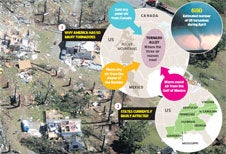Twister season is the deadliest since 1925
With emergency services knocked out or worked to breaking point, volunteers bring vital supplies to those left stranded across the southern states

Volunteers pitched in yesterday across the southern United States as residents tried to recover from the second-deadliest day for a tornado outbreak in US history. The death toll from Wednesday's storms keeps rising. At least 339 people were killed across seven states, including at least 248 in Alabama, as the storm system spawned tornadoes across the south.
Click HERE to upload graphic (253k jpg)
It was the largest death toll since 18 March 1925, when 747 people were killed in storms that raged through Missouri, Illinois and Indiana. That was long before the days when Doppler radar could warn communities of severe weather. Forecasters have said residents were told these tornadoes were coming, but they were just too wide and powerful. Thousands of people were injured – 990 in Tuscaloosa alone – and thousands of properties were destroyed. As many as one million Alabama homes and businesses remain without power.
Storms can still defeat technology. Emergency buildings were wiped out; bodies were being stored in refrigerated lorries, and authorities were left to beg for such basics as torches.
Volunteers stepped in to help almost as soon as the storms passed through. They ditched their jobs, spent their own money, donated blood, and even sneaked past police blockades to get aid to some of the hardest-hit communities. In Pratt City, Alabama, volunteers handed out water and groceries to residents of the ravaged Birmingham suburb. Down the road, dozens more volunteers transformed a local school into a community aid centre. One room was devoted to storing bread, another to sorting donated clothing. A doctor set up shop in one part of the building, and volunteers staffed the grille in front while college students formed an assembly line to unload lorries carrying fresh supplies.
Tuscaloosa's Mayor, Walt Maddox, called it "a humanitarian crisis" for his city of more than 83,000. Emergency services were stretched particularly thin in the demolished town of Hackleburg, Alabama, where officials had kept the dead in a refrigerated lorry because of a shortage of body bags. At least 27 people were killed there, and the search for missing people continued.
Tuscaloosa's emergency management centre was destroyed, so officials used space in one of the city's most prominent buildings – the University of Alabama's Bryant-Denny Stadium – as a substitute before moving operations to the Alabama Fire College. Volunteers set up a makeshift relief station at a car park in Alberta City, where scores of homes and businesses have been destroyed.
Subscribe to Independent Premium to bookmark this article
Want to bookmark your favourite articles and stories to read or reference later? Start your Independent Premium subscription today.

Join our commenting forum
Join thought-provoking conversations, follow other Independent readers and see their replies